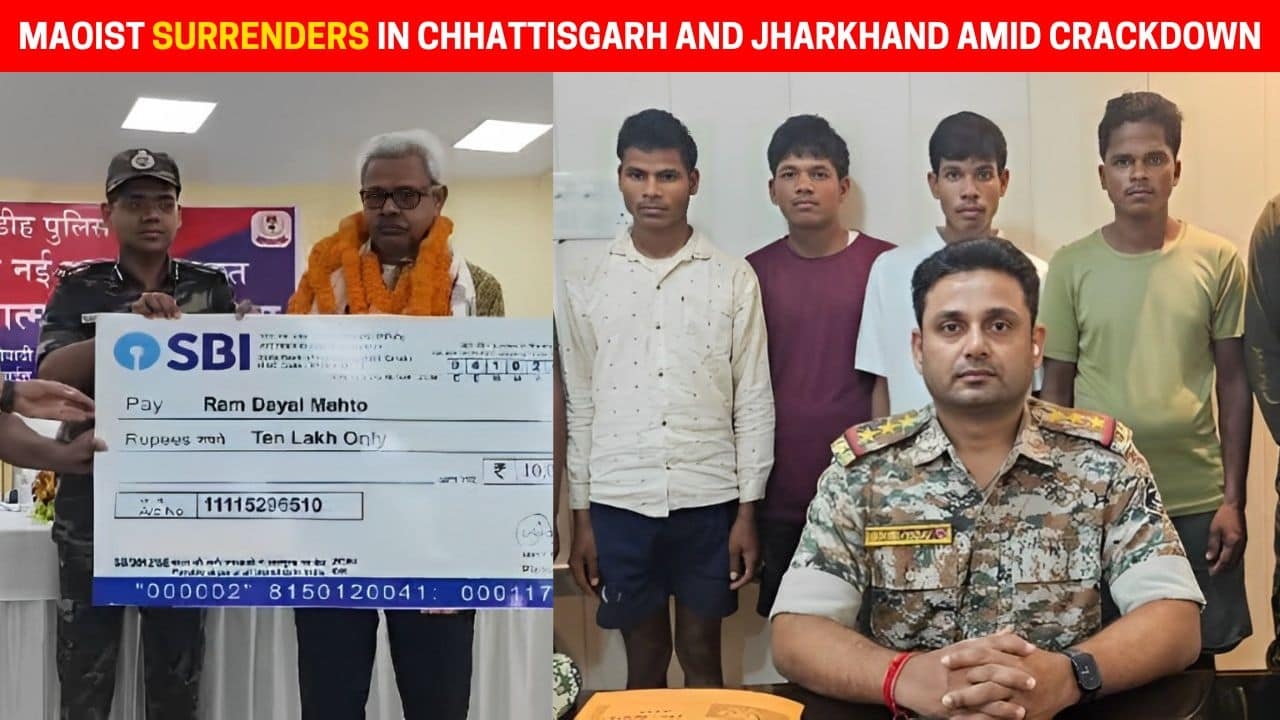Four Maoists Surrender in Chhattisgarh; Notorious Jharkhand Leader Also Lays Down Arms
29 Sep 2024 08:54:46

In a major boost to the ongoing efforts against the Maoist terrorism, two significant surrenders took place over the weekend, underscoring the success of rehabilitation policies in Maoist-affected regions.
In separate incidents, four Maoists in Chhattisgarh’s Sukma district and a notorious Maoist leader from Jharkhand, carrying a bounty of ₹10 lakh, surrendered to authorities.
Both surrenders highlight the growing disillusionment within Maoist ranks and the effectiveness of state-led initiatives aimed at bringing Maoists back into the mainstream.
Sukma Maoists Surrender Amid Anti-Naxal Operations
On Saturday, four Maoists from Sukma district in Chhattisgarh surrendered before security forces as part of an ongoing anti-Naxal operation.
The Maoists—identified as Madavi Bhima (20), Madavi Sukka (32), Kawasi Budhra (25), and Kunjam Muya (25)—were previously involved in various criminal activities, including plotting attacks on police patrols, planting improvised explosive devices (IEDs), and engaging in anti-government propaganda.
Their surrender is credited to the state’s 'Niyad Nella Naar' initiative, a community-driven program designed to offer locals an alternative to violence.
Disillusioned by the Maoist insurgency's brutal methods and the discriminatory treatment by senior leaders, the surrendered individuals cited frustration with the terrorist group’s inhumane practices as a significant factor in their decision to leave.
Police officials have confirmed that all four were involved in key Maoist activities aimed at disrupting security operations in the area, including digging up roads and placing banners against the government.
As part of the state’s ‘Chhattisgarh Naxal Eradication and Rehabilitation Policy,’ the surrendered Maoists will receive financial assistance of ₹25,000 each, along with support for reintegration into society.
The rehabilitation policy plays a central role in the government’s broader strategy to weaken the Maoist terrorism through a combination of force and welfare programs.
The surrender comes as the Centre continues to target a Maoist-free Chhattisgarh by 2026, with the state's efforts focusing on a multi-pronged approach that blends aggressive anti-Naxal operations with opportunities for Maoists to return to peaceful civilian life.
Jharkhand’s Notorious Maoist Leader Surrenders
On the same day, in Jharkhand, another significant surrender occurred when Ramdayal Mahto, a 70-year-old Maoist leader with a ₹10 lakh bounty on his head, laid down his arms.
Mahto, also known by his aliases Bachhan Daa and Nilesh Daa, had been one of the most wanted Maoists in the Giridih, Bokaro, and Dhanbad regions.
His surrender to the Deputy Inspector General (DIG) of Hazaribagh and the Superintendent of Police (SP) of Giridih is seen as a major success for the state’s efforts to curb Maoist activities in Jharkhand.
Mahto had been active in the Maoist Communist Centre (MCC) since the late 1980s and was involved in numerous high-profile crimes, including the bombing of Topchanchi police station in Dhanbad and the murder of a deputy village chief in 2022.
With 54 criminal cases registered against him, Mahto’s surrender marks a turning point in the state’s fight against Naxalism.
Police officials believe his decision to leave the Maoist insurgency is likely to encourage other Maoists to follow suit, especially given his influence as a key member of the Maoist zonal committee.
According to sources, Mahto’s surrender was influenced by both external pressures and internal disagreements within the Maoist leadership.
In recent years, he had become disillusioned with the extortion practices of his fellow members and faced opposition when proposing reforms within the group.
His growing isolation, combined with fears of an imminent police crackdown, ultimately led to his decision to surrender.
Rehabilitation Efforts and Future Prospects
Both surrenders are being hailed as major victories in the states’ ongoing battle against Maoism. In Chhattisgarh, the continued success of programs like ‘Niyad Nella Naar’ is seen as key to reducing the appeal of the Maoist terrorism among local populations.
Meanwhile, Jharkhand’s focus on intensifying its anti-Naxal operations, combined with its surrender and rehabilitation policies, is expected to further weaken Maoist activity in the state.
Officials believe that Mahto’s surrender, in particular, could have wide-reaching implications for the Maoist terrorism in Jharkhand, as he had long been a dominant figure in the region’s Maoist operations.
His departure from the insurgency, along with the surrender of younger cadres in Chhattisgarh, signals a growing disillusionment with the Maoist ideology, particularly as government efforts continue to gain momentum.
With the government’s ongoing push to curb Maoist violence through both force and rehabilitation, these surrenders offer hope for a more peaceful future in the insurgency-affected regions of India.
As officials continue to urge Maoists to lay down their arms, both Chhattisgarh and Jharkhand may soon see a further reduction in Maoist activities, paving the way for stability and development in these historically volatile areas.